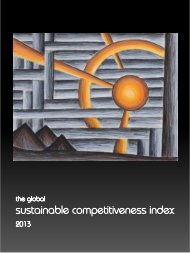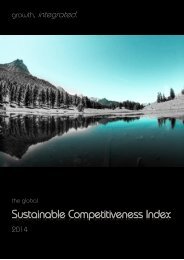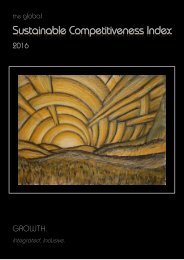The-Global-Sustainable-Competitiveness-Index-2015
Create successful ePaper yourself
Turn your PDF publications into a flip-book with our unique Google optimized e-Paper software.
Summary<br />
<strong>Sustainable</strong><br />
Competitive<br />
Natural<br />
Capital<br />
Resource<br />
Management<br />
Social<br />
Capital<br />
Intellectual<br />
Capital<br />
Governance<br />
Spotlight<br />
Data<br />
Methodology Development<br />
<strong>The</strong> competitiveness of a nation is influenced by a wide range of factors, i.e. is a<br />
complex matter. We are striving to develop a model that can reflect all aspects<br />
that define the level of competitiveness. <strong>The</strong> methodology for the <strong>Sustainable</strong><br />
<strong>Competitiveness</strong> is therefore constantly reviewed and has evolved over time. For<br />
the 2014 <strong>Index</strong>, the methodology has been overhauled significantly with a<br />
redesign of the <strong>Sustainable</strong> <strong>Competitiveness</strong> model and additional indicators<br />
added (71 in 2013, 104 in 2014). <strong>The</strong> changes to the <strong>Sustainable</strong> <strong>Competitiveness</strong><br />
Model and indicators have been undertaken based on past experiences, new<br />
research, data availability, and back-track analysis.<br />
Due to the changes in the methodology, rankings of the current rankings prior to<br />
2014 are not fully compatible with current rankings. While vast majority of<br />
countries remain in the same bracket of ranking despite the changes<br />
methodology, direct comparison of rankings have a limited informative value.<br />
From an index point of view, it might be preferable to base rankings on the same<br />
methodology and data. However, we believe that delivering the most accurate<br />
result possible is more important than direct of year-on-year rankings<br />
comparison. <strong>The</strong> main changes that have been implemented as a result of the<br />
methodology review include changes to the model of competitiveness on which<br />
the calculation is based, and further adaptation to availability of congruent<br />
data series.<br />
Changes to the sustainable competitiveness model<br />
<strong>The</strong> sustainable competitiveness model has been adapted based on review of<br />
the elements that characterise and influence sustainable competitiveness of<br />
nation-economy, and how those elements influence and impact each other.<br />
<strong>The</strong> model used for the 2012/2013 <strong>Index</strong> consisted of 4 key elements – Natural<br />
Capital, Resource Intensity, <strong>Sustainable</strong> Innovation, and Social Cohesion. Since<br />
2014, the <strong>Sustainable</strong> <strong>Competitiveness</strong> model is based on a pyramid with 5 levels.<br />
<strong>The</strong> basic conditions form the basis of the pyramid, on which the next level is built.<br />
Vice-versa, the higher levels of the pyramid are influencing the performance of<br />
the levels below.<br />
<br />
<br />
<br />
<br />
<br />
<strong>The</strong> base level of the Pyramid is the Natural Capital (the given physical<br />
environment and resources) – the resources that feed the population,<br />
provide energy, and materials<br />
<strong>The</strong> second level is Resource Management – the ability to use available<br />
resources at the highest possible efficiency - natural resources, human<br />
resources, intellectual resources, financial resources.<br />
<strong>The</strong> third level is the Social Capital of a country, the cohesion between<br />
generations, genders, income groups and other society groups. Social<br />
cohesion is required for the prosperous development of human capital,<br />
i.e. Social Capital is the provision of a framework that facilitates the third<br />
level of the pyramid<br />
<strong>The</strong> fourth level is the Intellectual Capital, the fundament for the ability to<br />
compete and generate wealth in a globalised competitive market<br />
through design and manufacturing of value-adding products and<br />
service. It is the basis for management capabilities<br />
<strong>The</strong> fifth and highest level is Governance – the direction and framework<br />
provided by government interventions, expenditure, and investments.<br />
Government policies (or the absence of such policies) have strong<br />
influence and or impact on all lower levels of the <strong>Sustainable</strong><br />
<strong>Competitiveness</strong> Pyramid.<br />
the sustainable competitiveness index <strong>2015</strong><br />
page 17








